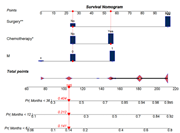Development of dynamic nomogram for predicting cancer-specific survival in hepatoid adenocarcinoma: A comprehensive SEER-based population analysis
DOI:
https://doi.org/10.17305/bb.2024.10445Keywords:
Hepatoid adenocarcinoma (HAC), cancer-specific survival (CSS), Surveillance, Epidemiology, and End Results (SEER) database, nomogramAbstract
Hepatoid adenocarcinoma (HAC) is a poorly differentiated extrahepatic tumor that can produce alpha-fetoprotein (AFP). The literature does not provide a comprehensive understanding of the prognostic factors for HAC. Therefore, we present a novel nomogram to predict the cancer-specific survival (CSS) of patients with HAC. We analyzed 265 cases of HAC from the Surveillance, Epidemiology, and End Results (SEER) database spanning from 2004 to 2015. Using a Cox proportional hazard regression model, we identified several risk factors and incorporated them into our predictive nomogram. The nomogram's predictive ability was assessed by utilizing the concordance index (C-index), calibration curve, and receiver operating characteristic (ROC). Results from a multivariate Cox regression showed that CSS was independently correlated with liver metastasis, surgery, and chemotherapy. Our nomogram had a C-index of 0.71 (95% CI 0.71-0.96). Furthermore, calibration curves demonstrated concordance between the predicted survival probability from the nomogram and the observed survival probability. The areas under the curve (AUC) for 6-month, 1-, and 3-year survival were 0.80, 0.82, and 0.88, respectively. Our study successfully formulated a prognostic nomogram that offers promising predictions for the 6-month, 1-, and 3-year CSS of patients with HAC. This nomogram holds potential for practical use in guiding treatment decisions and designing clinical trials.
Citations
Downloads

Downloads
Published
Data Availability Statement
The datasets analyzed during the current study are available in the SEER repository (https://seer.cancer.gov/data-software/). The dynamic nomogram is available at https://april-1998.shinyapps.io/dynamic_nomogram/.
Issue
Section
Categories
License
Copyright (c) 2024 Qing-Zhe Wang, Yi-Xin Zhou, Xiao-Li Mu, Jia-Ling Wang, Shuang Zhang, Ye Chen

This work is licensed under a Creative Commons Attribution 4.0 International License.









